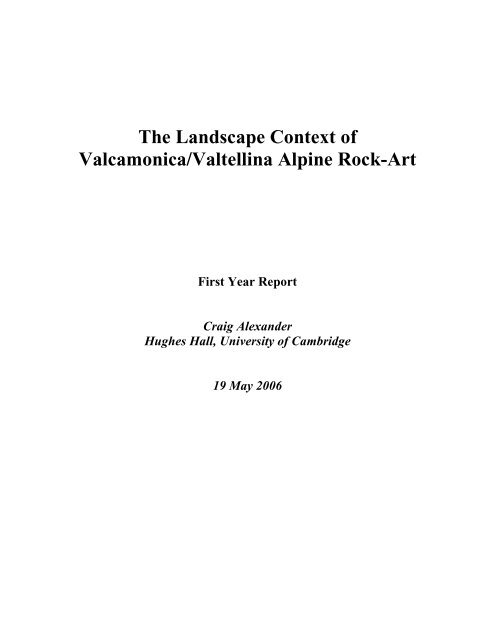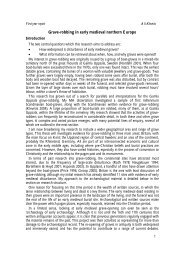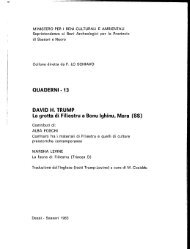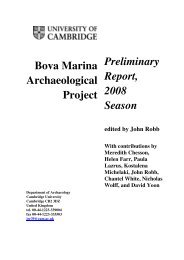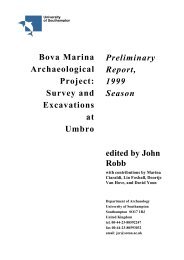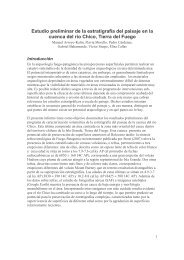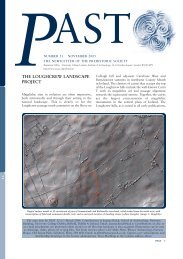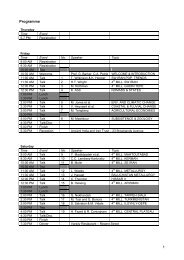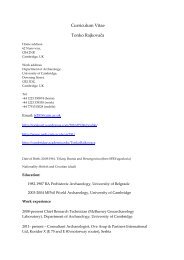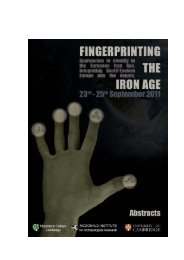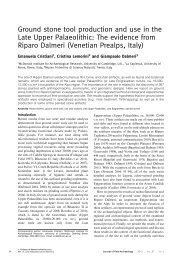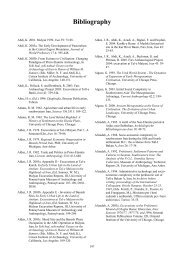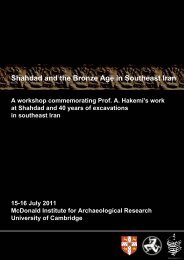The Landscape Context of Valcamonica/Valtellina Alpine Rock-Art
The Landscape Context of Valcamonica/Valtellina Alpine Rock-Art
The Landscape Context of Valcamonica/Valtellina Alpine Rock-Art
Create successful ePaper yourself
Turn your PDF publications into a flip-book with our unique Google optimized e-Paper software.
<strong>The</strong> <strong>Landscape</strong> <strong>Context</strong> <strong>of</strong><br />
<strong>Valcamonica</strong>/<strong>Valtellina</strong> <strong>Alpine</strong> <strong>Rock</strong>-<strong>Art</strong><br />
First Year Report<br />
Craig Alexander<br />
Hughes Hall, University <strong>of</strong> Cambridge<br />
19 May 2006
First Year Report – Craig Alexander<br />
<strong>The</strong> <strong>Landscape</strong> <strong>Context</strong> <strong>of</strong> <strong>Valcamonica</strong>/<strong>Valtellina</strong> <strong>Alpine</strong><br />
<strong>Rock</strong>-<strong>Art</strong><br />
Introduction<br />
<strong>The</strong> rock-art – petroglyphs and statue-menhirs/statue-stelae – <strong>of</strong> the <strong>Alpine</strong> valleys <strong>of</strong><br />
<strong>Valcamonica</strong> (see Figures 1 & 2) and <strong>Valtellina</strong> has long excited antiquarian and<br />
archaeological interest (e.g. Graziosi 1931, Marro, 1930 – referenced in Anati 1994:24 )<br />
and continues to do so today (e.g. Arcà 2005). Common designs include (purported)<br />
maps <strong>of</strong> fields (see Figure 6 below), daggers (see Figure 4 below), anthropomorphs<br />
(including the well-known oranti (praying/worshipping figures) – Figure 10) and plough<br />
teams (see Figures 7 & 8).<br />
Figure 1 <strong>Rock</strong>-art in Geographic <strong>Context</strong><br />
Source: Anati 1994:8<br />
1
First Year Report – Craig Alexander<br />
Figure 2 – <strong>Valcamonica</strong> from Il Capitello dei due Pini<br />
Source: Keates 2000:99<br />
<strong>Rock</strong>-art panels, particularly those exhibiting symbols from multiple periods, are<br />
examples <strong>of</strong> chronotopes (Bakhtin 1981:84, referenced in Ingold 2000:205-6) – that is,<br />
“place(s) charged with temporality, one(s) in which temporality takes a palpable form”<br />
(Ingold 2000:205). In Ingold’s view (2000), landscape is “congealed” taskscape, and<br />
temporality is the medium <strong>of</strong> taskscape – hence rock-art constitutes part <strong>of</strong> the ongoing<br />
process that is landscape. This is not, typically, a perspective that has been adopted in<br />
<strong>Alpine</strong> rock-art studies to date. Indeed, Bradley has written that most prior studies <strong>of</strong><br />
<strong>Alpine</strong> rock-art “lack an appropriate framework for interpreting it” (1997:8).<br />
I propose to (re)incorporate <strong>Alpine</strong> rock-art into the landscape context <strong>of</strong> which it should<br />
be regarded as an inseparable part. This aim will be accomplished through formal<br />
2
First Year Report – Craig Alexander<br />
analyses <strong>of</strong> the rock-art <strong>of</strong> a particular area, employing GIS tools in a variety <strong>of</strong> ways that<br />
focus on human experience – on what Ingold would term “dwelling”.<br />
<strong>The</strong> <strong>Rock</strong>-<strong>Art</strong><br />
Anati (1964:31-2) identified 12 distinct types <strong>of</strong> petroglyphs in <strong>Valcamonica</strong>, largely<br />
rendered on sandstone surfaces, (see Table 1). <strong>The</strong> surfaces include exposed rock<br />
surfaces (both flat and sloped), fallen boulders and deliberately erected statue-menhirs.<br />
Table 1 – Petroglyph types according to Anati (1964)<br />
o Human figures<br />
o Animals<br />
o Buildings and huts<br />
o Vehicles<br />
o Ploughs<br />
o Looms<br />
o Weapons and tools<br />
o Nets and traps<br />
o Labyrinths<br />
o Feet and hands<br />
o Geometric designs and abstract figures<br />
o Inscriptions and alphabetic characters<br />
3
First Year Report – Craig Alexander<br />
More recent authors (e.g. Arcà 2004, Fossati 2000) have further identified petroglyphs<br />
that they interpret as maps – these were most likely previously subsumed within Anati’s<br />
“Labyrinths” and “Geometric designs and abstract figures” categories.<br />
Examples <strong>of</strong> some <strong>of</strong> the more common petroglyph types are provided in Figures 3 to 12.<br />
Where photographs show the petroglyphs adequately I have used them, otherwise I have<br />
used the tracings recorded by, primarily, Anati’s teams. An unfortunate aspect <strong>of</strong> the<br />
tracings is that they erase the surface topography <strong>of</strong> the rock, thereby losing (or, one<br />
might say, disguising) information potentially vital to interpretation (see, e.g., Barfield &<br />
Chippindale 1997:113). One can see some <strong>of</strong> this impact by comparing Figures 3 and 4<br />
and Figures 7 and 8, which represent the same petroglyphs.<br />
Figure 3 – Cemmo, <strong>Valcamonica</strong> – boulder 1 – animals, Remedello daggers (at upper<br />
right)<br />
Source: Anati 1994:35<br />
4
First Year Report – Craig Alexander<br />
Figure 4 – Cemmo 1 – animals throughout, daggers to right<br />
Source: Keates 2000:95<br />
Figure 5 – Bedolina – “houses” at left, “fields”/”maps” throughout upper half <strong>of</strong> image<br />
Source: Anati 1964:106-7, edited by the current author<br />
5
First Year Report – Craig Alexander<br />
Figure 6 – Roccia 11, Seradina III – “map” at left, anthropomorphs and geometric<br />
figures to right.<br />
Source: Anati 1975:33<br />
6
Figure 7 – Stela Bagnolo II – plough at<br />
bottom, halberds at top right<br />
Source: Anati 1975:75<br />
First Year Report – Craig Alexander<br />
Figure 9 – Borno menhir – geometric patterns<br />
Source: Anati 1964:68<br />
7<br />
Figure 8 – Stela Bagnolo II – plough at<br />
bottom, halberds at top right<br />
Source: Anati 1975:74
First Year Report – Craig Alexander<br />
Figure 10 – Naquane roccia 50 – Oranti (praying/worshipping anthropomorphs)<br />
Source: Anati 1975:50<br />
8
Figure 11 – Later Iron Age Warrior<br />
Source: Anati 1964:186<br />
First Year Report – Craig Alexander<br />
Figure 12 – Cemmo 3 – anthropomorphs and daggers superposed on animals<br />
Source: Keates 2000:93<br />
9
First Year Report – Craig Alexander<br />
Whilst dating rock-art is notoriously difficult (see, e.g., Taçon & Chippindale 1998:6) the<br />
overall relative chronology <strong>of</strong> the <strong>Alpine</strong> forms is fairly widely agreed, although some<br />
disagreements persist, especially between followers <strong>of</strong> Anati and those <strong>of</strong> De Marinis.<br />
Dating has largely proceeded through two approaches: superposition and specific<br />
representations. First, it is reasonable to assume that a petroglyph incised over/through<br />
another must be later (see Figure 12 above). (Note, however, that it is not always that<br />
easy to tell which petroglyph cuts which, perhaps especially where weathering has been<br />
severe.) Second, certain <strong>of</strong> the objects represented (see, e.g., Figure 3 (Remedello<br />
dagger) and Figure 8 (plough, halberds) above) can be dated through independent means,<br />
providing, at worst, a terminus post quem for the representations.<br />
An example <strong>of</strong> a form that was – until recently, if not still – the object <strong>of</strong> controversy is<br />
the anthropomorphic form known (in the plural) as oranti. Anati (1994) claims these to<br />
be Late Neolithic/Chalcolithic while Fossati (2002:94) dates the oranti to the Bronze Age<br />
instead. Similarly, the “maps” have been previously claimed as Iron Age (Battaglia<br />
1934, referenced in Fossati 2002:99) and middle Bronze Age (Anati 1966, referenced in<br />
Fossati 2002:99) whereas Fossati (2002) dates them even earlier.<br />
Ignoring relatively infrequent medieval and modern additions, the bulk <strong>of</strong> the rock-art<br />
dates from later prehistory – between the Late Neolithic and the Iron Age (see Figure 13).<br />
10
Figure 13 – Petroglyphs by Period<br />
Source: Anati 1994:49<br />
Prior Research<br />
First Year Report – Craig Alexander<br />
My proposed research dwells at the confluence <strong>of</strong> three intellectual streams – landscape<br />
archaeology, rock-art studies and GIS. <strong>The</strong> volume <strong>of</strong> prior research in each <strong>of</strong> these<br />
fields is immense so I will here focus solely on those aspects most directly relevant to my<br />
own concerns.<br />
11
<strong>Landscape</strong> Archaeology<br />
First Year Report – Craig Alexander<br />
In terms <strong>of</strong> landscape archaeology, current perspectives commonly focus on the human<br />
experience. For example, Tilley (1994) has considered the experience <strong>of</strong> monuments in a<br />
phenomenological framework, as has Barrett (1994). Similarly, Ingold (on whose work<br />
Barrett, amongst others, has drawn) has, as noted above, argued for a phenomenological<br />
perspective in which the creation <strong>of</strong> landscape is ongoing:<br />
“In short, the landscape is the world as it is known to those who dwell<br />
therein, who inhabit its places and journey along the paths connecting<br />
them…. If the body is the form in which a creature is present as a being-in-<br />
the-world, then the world <strong>of</strong> its being-in presents itself in the form <strong>of</strong> the<br />
landscape. Like organism and environment, body and landscape are<br />
complementary terms: each implies the other, alternately as figure and<br />
ground.” (Ingold 2000:193)<br />
Brück & Goodman (1999) – in the context <strong>of</strong> settlement studies – also note that “place” is<br />
the result <strong>of</strong> cumulative practice, citing Barrett’s work as an example.<br />
Further, Jordan (2003:16-17) extends the logic <strong>of</strong> Barrett, Ingold et al to argue that<br />
“inhabited cultural landscapes” should, in fact, be considered as part <strong>of</strong> meaningfully<br />
constituted material culture and studied in that light.<br />
12
<strong>Rock</strong>-<strong>Art</strong> Studies<br />
First Year Report – Craig Alexander<br />
<strong>Rock</strong>-art studies in the Western Alps have, to date, focused primarily on the issues <strong>of</strong><br />
chronology (see page 10 above), (changes in) symbolic repertoire (e.g. Anati 1975) and<br />
meaning.<br />
Research has also tended to focus on larger panels with more symbols, a trend that<br />
continues to this day: in the most recently published work on <strong>Valcamonica</strong>, Arcà (2005)<br />
discusses the Dos Cüi panel which contains about 240 petroglyphs. Given Anati’s (1994)<br />
claim that there are about 200,000 petroglyphs distributed over 2,400 rocks (see Figures<br />
14 and 15) this suggests an average <strong>of</strong> about 80 petroglyphs per panel. <strong>The</strong> actual<br />
empirical distribution function <strong>of</strong> glyphs per panel across <strong>Valcamonica</strong> does not,<br />
however, appear to be available.<br />
<strong>The</strong> question <strong>of</strong> meaning is, naturally, more contentious. Anati (1994) sees the<br />
petroglyphs as quite straightforwardly representational <strong>of</strong> belief systems, a view strongly<br />
contested by, for example, Bradley who refers to “grandiose interpretations <strong>of</strong> the<br />
imagery based on the literature <strong>of</strong> comparative religion” (1997:8) and Chippindale &<br />
Nash, who write that Anati’s approach has “too much faith in unproven social universals”<br />
and “too little respect for the particular course <strong>of</strong> social change in any place or region.”<br />
(2004:16).<br />
13
Figure 14 – Spatial density <strong>of</strong><br />
petroglyphs<br />
Source: Anati 1975:25<br />
First Year Report – Craig Alexander<br />
14<br />
Figure 15 – Petroglyph locations –<br />
<strong>Valcamonica</strong>/<strong>Valtellina</strong><br />
Source: Anati 1994:6
First Year Report – Craig Alexander<br />
Fossati (1993, referenced in Fossati 2002:94) sees some rock-art (the “maps”) as perhaps<br />
a form <strong>of</strong> visual legitimation <strong>of</strong> land divisions imposed during agricultural development –<br />
a view that in some ways is echoed, in a different context, by Hartley & Wolley Vawser<br />
(1998) who see certain repeated petroglyphs in the American southwest as markers <strong>of</strong><br />
storage facility ownership. In the Mont Bégo context, however, de Lumley (1995,<br />
referenced in Arcà 2004:332-3) sees the topographic engravings as representing<br />
divinities.<br />
Other views have also been advanced: Robb (1994) saw the Later Neolithic and<br />
Chalcolithic rock-art as forming part <strong>of</strong> emerging strategies <strong>of</strong> gender inequality. Bevan<br />
(2000) also sees the art in the context <strong>of</strong> gender differentiation, but takes issue with<br />
Robb’s view <strong>of</strong>, for example, ploughing as a solely male practice.<br />
Keates (2000) sees the statue-menhirs, in particular, as representing ancestors in the<br />
landscape as part <strong>of</strong> a broader construction <strong>of</strong> memory and legitimation <strong>of</strong> territorial<br />
control. In this, his arguments are somewhat parallel to those advanced by Arcà (2004)<br />
and Fossati (2002).<br />
<strong>The</strong>re seems to have been little – quite possibly no – analysis <strong>of</strong> <strong>Valcamonica</strong> in<br />
shamanic terms (e.g. Lewis-Williams 2002), perhaps because almost all the images are<br />
believed to post-date predominantly hunter-gatherer lifeways in the valley. Interestingly,<br />
even though Lewis-Williams (2005) has recently extended his analysis into the Neolithic<br />
<strong>of</strong> Europe, the Italian <strong>Alpine</strong> sites warrant not one mention in his index.<br />
15
First Year Report – Craig Alexander<br />
<strong>The</strong> most sophisticated work to date on meaning appears to be that <strong>of</strong> Barfield &<br />
Chippindale (1997), who carefully consider patterns visible at Mont Bégo. <strong>The</strong> authors<br />
establish three principles for analysis: respect for context, focus on common/repeated<br />
rather than rare petroglyphs and employment <strong>of</strong> only the more robust cross-cultural<br />
analogies. Proceeding in light <strong>of</strong> these principles they posit that “the dagger (or halberd<br />
as its equivalent) is an icon <strong>of</strong> the status, the ‘social persona’ <strong>of</strong> the adult male….the<br />
Bégo rock-engravings (as) a statement <strong>of</strong> that adult male status” (1997:122). Further,<br />
they argue that the making <strong>of</strong> the images was probably more important than the finished<br />
product – perhaps forming part <strong>of</strong> a male initiation rite.<br />
GIS Applications<br />
Research in GIS applications in archaeology has been intense over the last 15 years or so<br />
(e.g. Lock & Stančič 1995, Lock 2000). Of particular interest are analyses <strong>of</strong><br />
intervisibility <strong>of</strong> sites, particularly those that recognize the differences between GIS<br />
“visibility” and human perception (e.g. Wheatley & Gillings 2000, Llobera 2003),<br />
analyses <strong>of</strong> the tensions between topographic and visual prominence (Llobera 2003) and<br />
analyses <strong>of</strong> visual exposure (Llobera 2003). While intervisibility analyses are well-<br />
known, it is worth briefly introducing Llobera’s concepts: topographic prominence refers<br />
to a location’s elevation relative to its surroundings while visual prominence is,<br />
essentially, the total viewshed – the number <strong>of</strong> places from which the location is<br />
intervisible. Combining these two measures <strong>of</strong> prominence one can identify, for<br />
16
First Year Report – Craig Alexander<br />
example, places that allow one to see much <strong>of</strong> the landscape but that are not, in<br />
themselves, topographically prominent. <strong>The</strong> concept <strong>of</strong> visual exposure attempts to<br />
measure not just whether one can see an object at a given location (as in viewshed<br />
analysis) but how much <strong>of</strong> the object one can see.<br />
More recently we have seen attempts to incorporate other senses into GIS models,<br />
particularly hearing (Mlekuz 2004). Such emphases on “experiential” aspects <strong>of</strong><br />
landscape, together with associated virtual reality (VRML) modelling, are beginning to<br />
bridge the gap that many (e.g. Gillings & Goodrick 1996, Llobera 1996, Wheatley &<br />
Gillings 2000, Wheatley & Gillings 2002) initially felt separated contemporary landscape<br />
archaeologies from GIS modelling. Indeed, Llobera (2001:1006) goes so far as to claim<br />
that such analyses can provide rigorous support to the somewhat impressionistic writings<br />
<strong>of</strong>, for example, Tilley (1994).<br />
<strong>Landscape</strong>, <strong>Rock</strong>-<strong>Art</strong> & GIS<br />
To date, these three streams <strong>of</strong> research have seen but limited interaction. Certainly,<br />
Arcà (2004) notes that visibility to/from panels could be important, and notes,<br />
impressionistically, that many sites containing “map” petroglyphs command fine views<br />
over the valley (see Figure 16) but are not especially visible, being on horizontal surfaces.<br />
Similarly, Chippindale & Nash write that:<br />
17
First Year Report – Craig Alexander<br />
“So the pattern <strong>of</strong> occurrence in those <strong>Alpine</strong> valleys, as we know it, is an<br />
intricate consequence <strong>of</strong> where the rock was available for rock-engraving in<br />
prehistoric times, <strong>of</strong> where the rock surfaces that were used have and have<br />
not been covered over, <strong>of</strong> where chance observations and systematic surveys<br />
have led to their notice, and <strong>of</strong> where the effort to clear and expose surfaces<br />
has been made.” (2004:11)<br />
Figure 16 – <strong>Rock</strong>-art at Vite, <strong>Valcamonica</strong> – view from panel at left, photograph <strong>of</strong> panel<br />
at top right and tracing <strong>of</strong> panel at lower right<br />
Source: Arcà 2004:334<br />
None <strong>of</strong> these authors has, however, undertaken GIS-based analyses to substantiate their<br />
claims. GIS applications in rock-art archaeology appear to date, to be but four: Gaffney,<br />
18
First Year Report – Craig Alexander<br />
Stančič & Watson (1995), Hartley & Wolley Vawser (1998), Moscrop (2002) and<br />
Robinson (2006). Gaffney et al presented a straightforward intervisibility analysis <strong>of</strong><br />
rock-art and other monuments in Kilmartin, Scotland. Hartley & Wolley Vawser’s work<br />
sits firmly in the tradition <strong>of</strong> cultural ecology and thus outside contemporary British<br />
archaeological practice. Moscrop’s work is similar to Gaffney et al but undertaken in<br />
West Yorkshire. Robinson has used GIS to look at the location <strong>of</strong> Native American rock-<br />
art relative to human tasks and also at the privileging <strong>of</strong> viewsheds from the panels.<br />
Research Questions<br />
What, then, was the role <strong>of</strong> the rock-art <strong>of</strong> the Western Alps in the process <strong>of</strong> (re)creating<br />
the landscape, particularly between the Neolithic and Iron Ages? Starting from a<br />
“dwelling” perspective (see page 12 above), we view the landscape as “the congealed<br />
form <strong>of</strong> taskscape” (Ingold 2000:199). Thus, the landscape is always becoming and is<br />
never at rest. <strong>The</strong> landscape <strong>of</strong> the Chalcolithic builds on that <strong>of</strong> the Neolithic, the<br />
landscape <strong>of</strong> the Bronze Age on that <strong>of</strong> the Chalcolithic and so on – until we,<br />
contemporary archaeologists, add the latest, but by no means final, elements to the<br />
landscape.<br />
What does this imply in terms <strong>of</strong> research questions? In short, it suggests hypotheses<br />
both synchronic and diachronic about the relationships <strong>of</strong> petroglyph sites and other<br />
landscape elements: topographical, hydrological and anthropogenic.<br />
19
First Year Report – Craig Alexander<br />
Considering first the synchronic hypotheses we can see that, if the petroglyphs form part<br />
<strong>of</strong> the taskscape (as, for example, Barfield & Chippindale’s work at Mont Bégo argues<br />
that they do) then we might expect some regularities in their deposition within a given<br />
period. Whilst we cannot identify the “hand” <strong>of</strong> an individual carver and so tell directly<br />
whether multiple people carved at a given site we can look for concentrations <strong>of</strong><br />
petroglyphs that can be dated to a given period. Are they at similar altitudes? Are they<br />
near known settlements? Are they on particular soil-types? Does their distribution<br />
coincide with likely activity areas? Do they coincide with expected paths between<br />
settlements (or, more broadly, the valley floor) and higher land? Are the sites<br />
intervisible? Are they interaudible?<br />
Considering, as a specific example, the “maps” – are Arcà and Fossati correct in viewing<br />
the “maps” as reflecting land tenure? If they do, and if the “map” panels are<br />
contemporary, what do they imply about farm-size? Are “map” petroglyph sites<br />
intervisible? Even though Arcà notes that “maps” are found on flat rocks it is still<br />
possible that their locations could have been known to all or some members <strong>of</strong> society –<br />
and perhaps even marked in ways no longer extant? Are the sites inter-audible? If one<br />
accepts the land tenure hypothesis one could imagine a ritual that reinforced boundaries<br />
taking place at these sites, something like the English traditions <strong>of</strong> marking parish<br />
boundaries. How long would it take to walk between the “maps”? How would varying<br />
weather conditions – fog, snow, rain – impact the geospatial relationships? Do the sites<br />
lie along likely routes <strong>of</strong> travel? Do they lie above the likely level <strong>of</strong> fog, thereby<br />
informing a traveller <strong>of</strong> changes <strong>of</strong> land tenure even when the valley is obscured?<br />
20
First Year Report – Craig Alexander<br />
Moving now to diachronic hypotheses we can ask about the formation <strong>of</strong> place from<br />
space – which sites were re-used over time? Are they simply the easiest <strong>of</strong> access? What<br />
are their characteristics? Are they close to water? Close to paths? At places <strong>of</strong> greater<br />
than average viewshed? At places <strong>of</strong> enhanced visual exposure? Do certain petroglyphs<br />
from one period typically co-occur with certain types from earlier periods? Do the<br />
locational characteristics <strong>of</strong> sites with a predominance <strong>of</strong> later petroglyph forms differ<br />
from those with a predominance <strong>of</strong> earlier forms? What does this tell us about the<br />
changing interrelationships <strong>of</strong> people, activities and land?<br />
More general questions also suggest themselves: Are particular petroglyphs typically<br />
oriented in particular ways (as Barfield & Chippindale 1997 suggest can be the case)?<br />
How are large and small petroglyph panels situated relative to each other and to other<br />
landscape features, both geologic/hydrologic and anthropogenic?<br />
In sum, my research will not only provide new insight into the changing landscape<br />
context <strong>of</strong> the rock-art <strong>of</strong> <strong>Valcamonica</strong> but will also demonstrate the value <strong>of</strong> the<br />
application <strong>of</strong> “experiential” or “humanistic” GIS in the context <strong>of</strong> rock-art archaeology –<br />
if any element <strong>of</strong> the archaeological record deserves to be seen this way it is surely the<br />
<strong>of</strong>ten seemingly intensely personal images <strong>of</strong> rock-art.<br />
21
Bibliography<br />
First Year Report – Craig Alexander<br />
ALDENDERFER, M. & MASCHNER, H.D.G. (eds.) 1996. Anthropology, Space, and<br />
Geographic Information Systems. (Spatial Information Series). Oxford, UK: Oxford<br />
University Press.<br />
ANATI, E. 1964. Camonica Valley: A Depiction <strong>of</strong> Village Life in the Alps to the Birth <strong>of</strong><br />
Christ as Revealed by Thousands <strong>of</strong> Newly Found <strong>Rock</strong> Carvings. London, UK: Jonathan<br />
Cape.<br />
ANATI, E. 1966. Il Masso di Borno. (Pubblicazione dek Centro 2). Breno, Italy: Centro<br />
Camuno di Studi Preistorici.<br />
ANATI, E. 1975. Evoluzione e Stile nell’<strong>Art</strong>e Rupestre Camuna. (Archivi 6). Capo di<br />
Ponte (BS), Italy: Edizioni del Centro.<br />
ANATI, E. 1994. <strong>Valcamonica</strong> <strong>Rock</strong> <strong>Art</strong>: A New History for Europe. (Studi<br />
CamuniVolume XIII). Capo di Ponte (BS), Italy: Edizioni del Centro.<br />
ARCÀ, A. 2000. Agricultural landscapes in Neolithic and Copper Age engravings <strong>of</strong><br />
<strong>Valcamonica</strong> and Mt. Bégo <strong>Rock</strong> <strong>Art</strong>” In NASH, G. (ed.). Signifying Place and Space:<br />
World Perspectives <strong>of</strong> <strong>Rock</strong> <strong>Art</strong> and <strong>Landscape</strong>, 29-40 (BAR International Series 902).<br />
Oxford, UK: Archaeopress.<br />
ARCÀ, A. 2004. <strong>The</strong> topographic engravings <strong>of</strong> <strong>Alpine</strong> rock-art: fields, settlements, and<br />
agricultural landscapes. In CHIPPINDALE, C. & NASH, G. (eds.) <strong>The</strong> Figured <strong>Landscape</strong>s <strong>of</strong><br />
<strong>Rock</strong>-<strong>Art</strong>: Looking at Pictures in Place, 318-350. Cambridge, UK: Cambridge<br />
University Press.<br />
22
First Year Report – Craig Alexander<br />
ARCÀ, A. 2005. Archeologia rupestre in <strong>Valcamonica</strong>: Dos Cüi, un caso di studio. Rivista<br />
di Scienze Preistoriche 40, 323-384.<br />
BAKHTIN, M.M. (TRANS. EMERSON, C. & HOLQUIST, M.) 1981. <strong>The</strong> dialogic imagination:<br />
four essays. Austin, Texas, USA: University <strong>of</strong> Texas Press.<br />
BARFIELD, L. & CHIPPINDALE, C. 1997. Meaning in the Later Prehistoric <strong>Rock</strong>-<br />
Engravings <strong>of</strong> Mont Bégo, Alpes-Maritimes, France. Proceedings <strong>of</strong> the Prehistoric<br />
Society 63, 103-128.<br />
BARRETT, J.C. 1994. Fragments from Antiquity: An Archaeology <strong>of</strong> Social Life in Britain,<br />
2900-1200BC. Oxford, UK: Blackwell.<br />
BATTAGLIA, R. 1934. Ricerche etnografiche sui petroglifi della cerchia alpine. Studi<br />
etruschi 8:11-48.<br />
BEVAN, L. 2000. Women’s <strong>Art</strong>, Men’s <strong>Art</strong>: Gender Specific Image Selection in the <strong>Rock</strong><br />
<strong>Art</strong> <strong>of</strong> <strong>Valcamonica</strong>. In NASH, G. (ed.). Signifying Place and Space: World Perspectives<br />
<strong>of</strong> <strong>Rock</strong> <strong>Art</strong> and <strong>Landscape</strong>, 103-109 (BAR International Series 902). Oxford, UK:<br />
Archaeopress.<br />
BRADLEY, R. 1997. <strong>Rock</strong> <strong>Art</strong> and the Prehistory <strong>of</strong> Atlantic Europe: Signing the Land.<br />
London, UK: Routledge.<br />
BRÜCK, J. & GOODMAN, M. 1999. Introduction: themes for a critical archaeology <strong>of</strong><br />
prehistoric settlement. In BRÜCK, J. & GOODMAN, M. (eds.) Making Places in the<br />
Prehistoric World: <strong>The</strong>mes in Settlement Archaeology, 1-19. London, UK: UCL Press.<br />
BRÜCK, J. & GOODMAN, M. 1999. Making Places in the Prehistoric World: <strong>The</strong>mes in<br />
Settlement Archaeology. London, UK: UCL Press.<br />
23
First Year Report – Craig Alexander<br />
CASINI, S. (ed.)1994. Le pietre degli dei: menhir e stele dell’Età del Rame in<br />
<strong>Valcamonica</strong> e <strong>Valtellina</strong>. Bergamo, BS, Italy: Centro Culturale Nicolò Rezzara.<br />
CHIPPINDALE, C. 2004. From millimetre up to kilometre: a framework <strong>of</strong> space and <strong>of</strong><br />
scale for reporting and studying rock-art in its landscape. In CHIPPINDALE, C. & NASH, G.<br />
(eds.) <strong>The</strong> Figured <strong>Landscape</strong>s <strong>of</strong> <strong>Rock</strong>-<strong>Art</strong>: Looking at Pictures in Place, 102-17.<br />
Cambridge, UK: Cambridge University Press.<br />
CHIPPINDALE, C. & TAÇON, P.S.C. (eds.) 1998. <strong>The</strong> Archaeology <strong>of</strong> <strong>Rock</strong>-<strong>Art</strong>. Cambridge,<br />
UK: Cambridge University Press.<br />
CHIPPINDALE, C. & NASH, G. 2004. Pictures in place: approaches to the figured<br />
landscapes <strong>of</strong> rock-art. In CHIPPINDALE, C. & NASH, G. (eds.) <strong>The</strong> Figured <strong>Landscape</strong>s <strong>of</strong><br />
<strong>Rock</strong>-<strong>Art</strong>: Looking at Pictures in Place, 1-36. Cambridge, UK: Cambridge University<br />
Press.<br />
CHIPPINDALE, C. & NASH, G. (eds.) 2004. <strong>The</strong> Figured <strong>Landscape</strong>s <strong>of</strong> <strong>Rock</strong>-<strong>Art</strong>: Looking<br />
at Pictures in Place. Cambridge, UK: Cambridge University Press.<br />
CONOLLY, J. & LAKE, M. 2006. Geographical Information Systems in Archaeology.<br />
(Cambridge Manuals in Archaeology). Cambridge, UK: Cambridge University Press.<br />
FOSSATI, A. 1993. Il mondo dei Camuni: l’arte rupestre della <strong>Valcamonica</strong>.<br />
(<strong>Valcamonica</strong> Preistorica 4). Cerveno, Italy: Edizioni della Cooperative Archaeologica<br />
Le Orme dell’Uomo.<br />
FOSSATI, A. 2000. <strong>Landscape</strong> representations on boulders and menhirs in the<br />
<strong>Valcamonica</strong>-<strong>Valtellina</strong> area, <strong>Alpine</strong> Italy. In NASH, G. & CHIPPINDALE, C. (eds.)<br />
European <strong>Landscape</strong>s <strong>of</strong> <strong>Rock</strong>-<strong>Art</strong>, 93-115. London, UK: Routledge.<br />
24
First Year Report – Craig Alexander<br />
FOSSATI, A. 2002. <strong>Landscape</strong> representations on boulders and menhirs in the<br />
<strong>Valcamonica</strong>-<strong>Valtellina</strong> area, <strong>Alpine</strong> Italy. In NASH, G. & CHIPPINDALE, C. (eds.)<br />
European <strong>Landscape</strong>s <strong>of</strong> <strong>Rock</strong>-<strong>Art</strong>, 93-115. London, UK: Routledge.<br />
FRACHETTI, M. & CHIPPINDALE, C. 2000. <strong>Alpine</strong> imagery, <strong>Alpine</strong> space, <strong>Alpine</strong> time; and<br />
prehistoric human experience. In NASH, G. & CHIPPINDALE, C. (eds.) European<br />
<strong>Landscape</strong>s <strong>of</strong> <strong>Rock</strong>-<strong>Art</strong>, 116-143. London, UK: Routledge.<br />
GAFFNEY, V, STANČIČ, Z., & WATSON, H. 1995. Moving from Catchments to Cognition:<br />
Tentative Steps Toward a Larger Archaeological <strong>Context</strong> for GIS. IN ALDENDERFER, M.<br />
& MASCHNER, H.D.G. (eds.) Anthropology, Space, and Geographic Information Systems,<br />
132-154. (Spatial Information Series). Oxford, UK: Oxford University Press.<br />
GILLINGS, M. & GOODRICK, G.T. 1996. Sensuous and Reflexive GIS: exploring<br />
visualization and VRML. Internet Archaeology 1:<br />
http://intarch.ac.uk/journal/issue1/gillings_index.html. Accessed 30 March 2006.<br />
GRAZIOSI, P. 1931. Le incisioni preistoriche di <strong>Valcamonica</strong>. Archivio per l’Antropologia<br />
e l’Ethnologia 59, 1-8.<br />
HARTLEY, R. & WOLLEY VAWSER, A.M. 1998. Spatial behaviour and learning in the<br />
prehistoric environment <strong>of</strong> the Colorado River drainage (south-eastern Utah), western<br />
North America. In CHIPPINDALE, C. & TAÇON, P.S.C. (eds.) <strong>The</strong> Archaeology <strong>of</strong> <strong>Rock</strong>-<strong>Art</strong>,<br />
185-211. Cambridge, UK: Cambridge University Press.<br />
HIGUCHI, T. (TRANS. TERRY, C.S.) 1983 (1975). <strong>The</strong> Visual and Spatial Structure <strong>of</strong><br />
<strong>Landscape</strong>s. Cambridge, MA, USA: MIT Press.<br />
INGOLD, T. 2000. <strong>The</strong> temporality <strong>of</strong> the landscape. In INGOLD, T. <strong>The</strong> Perception <strong>of</strong> the<br />
Environment: Essays in livelihood, dwelling and skill, 198-208. London, UK: Routledge.<br />
25
First Year Report – Craig Alexander<br />
INGOLD, T. 2000. <strong>The</strong> Perception <strong>of</strong> the Environment: Essays in livelihood, dwelling and<br />
skill. London, UK: Routledge.<br />
JORDAN, P. 2003. Material Culture and Sacred <strong>Landscape</strong>: <strong>The</strong> Anthropology <strong>of</strong> the<br />
Siberian Khanty. Walnut Creek, CA, USA: Alta Mira Press.<br />
KEATES, S. 2000. <strong>The</strong> Ancestralization <strong>of</strong> the <strong>Landscape</strong>: Monumentality, Memory and<br />
the <strong>Rock</strong> <strong>Art</strong> <strong>of</strong> the Copper Age <strong>Valcamonica</strong>. In NASH, G. (ed.). Signifying Place and<br />
Space: World Perspectives <strong>of</strong> <strong>Rock</strong> <strong>Art</strong> and <strong>Landscape</strong>, 83-102 (BAR International Series<br />
902). Oxford, UK: Archaeopress.<br />
LEWIS-WILLIAMS, J.D. 2002. <strong>The</strong> Mind in the Cave: Consciousness and the Origins <strong>of</strong><br />
<strong>Art</strong>. London, UK: Thames & Hudson.<br />
LEWIS-WILLIAMS, J.D. & PEARCE, D. 2005. Inside the Neolithic Mind: Consciousness,<br />
Cosmos and the Realm <strong>of</strong> the Gods. London, UK: Thames & Hudson.<br />
LLOBERA, M. 1996. Exploring the topography <strong>of</strong> mind: GIS, social space and<br />
archaeology. Antiquity 70:612-22.<br />
LLOBERA, M. 2001. Building Past <strong>Landscape</strong> Perception With GIS: Understanding<br />
Topographic Prominence. Journal <strong>of</strong> Archaeological Science 28:1005-14.<br />
LLOBERA, M. 2003. Extending GIS-based visual analysis: the concept <strong>of</strong> visualscapes.<br />
International Journal <strong>of</strong> Geographical Information Science 17:25-48.<br />
LOCK, G. (ed.) 2000. Beyond the Map: Archaeology and Spatial Technologies. (NATO<br />
Science Series Vol. 321). Oxford, UK: IOS Press.<br />
LOCK, G. & STANČIČ, Z. (eds.) 1995. Archaeology and Geographical Information<br />
Systems. London, UK: Taylor & Francis.<br />
26
First Year Report – Craig Alexander<br />
LUMLEY, H. DE et al. 1995. Le Grandiose et le sacré: gravures rupestres protohistoriques<br />
et historiques de la région du Mount Bego. Aix-en-Provence, France: Edisud.<br />
MARRO, G. 1930. <strong>Art</strong>e rupestre zoomorphica in <strong>Valcamonica</strong>. Rivista di Anthropologia<br />
29, 1-39.<br />
MLEKUZ, D. 2004. Listening to <strong>Landscape</strong>s: Modelling Past Soundscapes in GIS. Internet<br />
Archaeology 16: http://intarch.ac.uk/journal/issue16/mlekuz_index.html. Accessed 30<br />
March 2006.<br />
MOSCROP, D. 2002. A GIS Based Analysis <strong>of</strong> the Prehistoric <strong>Rock</strong> Carvings and<br />
Archaeological Sites in the Rombalds Moor Region, West Yorkshire. Unpublished MA<br />
dissertation, University <strong>of</strong> Birmingham, UK.<br />
NASH, G. (ed.) 2000. Signifying Place and Space: World Perspectives <strong>of</strong> <strong>Rock</strong> <strong>Art</strong> and<br />
<strong>Landscape</strong>. (BAR International Series 902). Oxford, UK: Archaeopress.<br />
NASH, G. & CHIPPINDALE, C. 2002. (Eds.) European <strong>Landscape</strong>s <strong>of</strong> <strong>Rock</strong>-<strong>Art</strong>. London,<br />
UK: Routledge.<br />
ROBB, J.E. 1994. Gender Contradictions, Moral Coalitions, and Inequality in Prehistoric<br />
Italy. Journal <strong>of</strong> European Archaeology 2:20-49.<br />
ROBINSON, D.W. 2006. <strong>Landscape</strong>, Taskscape and Indigenous Perception: <strong>Rock</strong>-<strong>Art</strong> <strong>of</strong><br />
South-Central California. Unpublished PhD thesis, University <strong>of</strong> Cambridge, UK.<br />
TAÇON, P.S.C. & CHIPPINDALE, C. 1998. An archaeology <strong>of</strong> rock-art through informed<br />
methods and formal methods. In CHIPPINDALE, C. & TAÇON, P.S.C. (Eds.) <strong>The</strong><br />
Archaeology <strong>of</strong> <strong>Rock</strong>-<strong>Art</strong>, 1-10. Cambridge, UK: Cambridge University Press.<br />
TILLEY, C. 1994. A Phenomenology <strong>of</strong> <strong>Landscape</strong>: Places, Paths and Monuments.<br />
Oxford, UK: Berg.<br />
27
First Year Report – Craig Alexander<br />
WALLER, S.J. 2000. Spatial Correlation <strong>of</strong> Acoustics and <strong>Rock</strong> <strong>Art</strong> Exemplified in<br />
Horseshoe Canyon. American Indian <strong>Rock</strong> <strong>Art</strong> 24, 85-94.<br />
WHEATLEY, D. 1995. Cumulative viewshed analysis: a GIS-based method for<br />
investigating intervisibility, and its archaeological application. In LOCK, G. & STANČIČ, Z.<br />
(Eds.). Archaeology and Geographical Information Systems, 171-186. London, UK:<br />
Taylor & Francis.<br />
WHEATLEY, D. & GILLINGS, M. 2000. Vision, perception and GIS: developing enriched<br />
approaches to the study <strong>of</strong> archaeological visibility. In LOCK, G. (Ed.). Beyond the Map:<br />
Archaeology and Spatial Technologies, 1-27. (NATO Science Series Vol. 321). Oxford,<br />
UK: IOS Press.<br />
WHEATLEY, D. & GILLINGS, M. 2002. Spatial Technology and Archaeology: <strong>The</strong><br />
Archaeological Applications <strong>of</strong> GIS. London, UK: Taylor & Francis.<br />
WILSON, A. 2006. A hybrid viewshed analysis. Unpublished paper presented at CAA UK,<br />
University <strong>of</strong> Southampton, 31 March 2006.<br />
28


